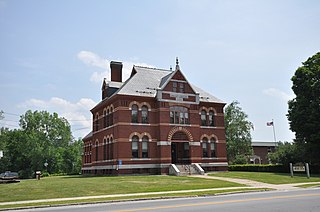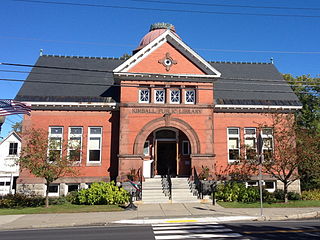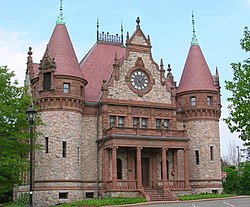
Wellesley is a town in Norfolk County, Massachusetts, United States. Wellesley is part of Greater Boston. The population was 29,550 at the time of the 2020 census. Wellesley College, Babson College, and a campus of Massachusetts Bay Community College are located in the town.

The H. H. Hunnewell estate in Wellesley, Massachusetts was the country home of H. H. Hunnewell (1810–1902), containing over 500 species of woody plants in 53 families. The estate remains in the family, and includes the first (1854) topiary garden in the United States, featuring intricate geometrically clipped native Eastern white pine and Eastern arborvitae. A collection of specialty greenhouses feature over 1,000 plant species. The estate has been cared for by six generations of the Hunnewell family.
Horatio Hollis Hunnewell was an American railroad financier, philanthropist, amateur botanist, and one of the most prominent horticulturists in America in the nineteenth century. Hunnewell was a partner in the private banking firm of Welles & Co. Paris, France controlled by his in-laws, which specialized in trade finance between the two countries. Practicing horticulture for nearly six decades on his estate in Wellesley, Massachusetts, he was perhaps the first person to cultivate and popularize rhododendrons in the United States.

Hamilton Hall is a National Historic Landmark at 9 Chestnut Street in Salem, Massachusetts. Designed by noted Salem builder Samuel McIntire and built in 1805–1807, it is an excellent instance of a public Federal style building. It was built as a social space for the leading families of Salem, and was named for Founding Father and Federalist Party leader Alexander Hamilton. It continues to function as a social hall today: it is used for events, private functions, weddings and is also home to a series of lectures that originated in 1944 by the Ladies Committee.

The former First Unitarian Church is a historic church building at 130 Highland Avenue in Somerville, Massachusetts. The stone church was built in 1894 for a Unitarian congregation. It was designed by Hartwell & Richardson and is a good example of Richardsonian Romanesque design. The building presently (2022) houses the Mission Church of Our Lord Jesus Christ.

The Warren Public Library is the public library of Warren, Massachusetts, It is located at 934 Main Street, in a Richardsonial Romanesque building designed by Amos P. Cutting and built in 1889. The building was listed on the National Register of Historic Places in 2000.

The Hunnewell Estates Historic District is an historic district between the Charles River and Lake Waban in Wellesley and Natick, Massachusetts, about 17 miles west of Boston. It consists of the large group of 18th to 21st century agricultural and estate properties with farmland, gardens, residences, and landscapes of the Hunnewell and Welles families. The properties in the Historic District are still largely owned and occupied by members of the Hunnewell family. It was added to the National Register of Historic Places in 1988.

Hyde School is a historic Romanesque Revival school at 130 High Street in Lee, Massachusetts. The school was built in 1894 from locally quarried marble. It is named for Alexander Hyde, who established the town's first school in his house on West Park Street, and was built on the site of the town's first public school.

Ware Town Hall is a historic town hall at Main and West Streets in Ware, Massachusetts. It was built in 1885 to a design by the architectural firm of Hartwell and Richardson, and is a prominent local example of Romanesque Revival architecture. The building, enlarged in 1904 and 1935 with stylistically sensitive additions, was listed on the National Register of Historic Places in 1986.

Palmer Memorial Hall is a historic hall at 1029 Central Street in Palmer, Massachusetts, United States. The Romanesque building was designed by New York City architect R. H. Robertson and constructed in 1890 as a memorial to the town's Civil War dead; it was also used as a meeting space by the local Grand Army of the Republic veterans society. The ground floor served as the town's public library until 1977. It has since served as Palmer's Senior Center. The building was listed on the National Register of Historic Places in 1999.

Andover Town Hall is the historic town hall of Andover, Massachusetts. It is located at 20 Main Street, between Park and Barnard Streets. The 2+1⁄2 story Romanesque Revival red brick building was constructed in 1858, not long after the separation of North Andover. It was designed by Boston architect Theodore Voelkers and built by local builders Abbott & Clement. The building design echoed that of the mills that dotted the town. It was listed on the National Register of Historic Places in 1982.

The Musgrove Block is a historic commercial building at 2 Main Street in the center of Andover, Massachusetts. The three-story brick building was built in 1895 on the site of a former town green, and forms part of Andover's central Elm Square intersection. The building exhibits Romanesque Revival styling, featuring granite trim elements and ornate brick detailing. It was listed on the National Register of Historic Places in 1982.

The Conant Public Library is the public library of Winchester, New Hampshire. It is located at 111 Main Street, in a fine Victorian Romanesque Revival building erected in 1891, funded by a bequest from Winchester resident Ezra Conant. The building's design, by Springfield, Massachusetts architect, J. M. Currier, is based on his design of the 1886 library building in Brattleboro, Vermont, and is one of the most architecturally distinguished buildings in Cheshire County. It was listed on the National Register of Historic Places in 1987.

Brewster Memorial Hall is the town hall of Wolfeboro, New Hampshire. It is located at the junction of South Main Street and Union Street in the town center. Its construction in 1880-90 was the result of a bequest from Wolfeboro native John W. Brewster, with terms stipulating that the building should resemble Sargent Hall in Merrimac, Massachusetts. It was listed on the National Register of Historic Places in 1983.

The Wakefield Town Hall and Opera House is a historic municipal building at 2 High Street in the Sanbornville village of Wakefield, New Hampshire. Built in 1895, it is a prominent local example of Romanesque architecture, and has housed civic and social activities since its construction. The building was listed on the National Register of Historic Places in 2007, and the New Hampshire State Register of Historic Places in 2002.

Bennington station is a historic former railroad depot at 150 Depot Street in downtown Bennington, Vermont. Built in 1897-98 by the Bennington and Rutland Railroad, it is the only Richardsonian Romanesque railroad station in the state of Vermont. It was listed on the National Register of Historic Places in 1988 as Bennington Railroad Station, and since then housed a restaurant, which closed in 2018. It now is an office space for MSK Engineering and Design and Goldstone Architecture.

Reading Town Hall, the town hall of Reading, Vermont, is located at the junction of Vermont Route 106 and Pleasant Street in the village of Felchville. Built in 1915 as a gift from a native son, the barn-like structure is a fine local example of Colonial Revival architecture, and has been a center of local civic activity since its construction. It was listed on the National Register of Historic Places in 1996.

The Kimball Public Library is the public library serving Randolph, Vermont. It is located at 67 Main Street, just north of the town center, in an architecturally distinguished building donated by Col. Robert Kimball, a Randolph native. Built in 1902, it was listed on the National Register of Historic Places in 1985.

St. Albans Town Hall is the center of government of the town of St. Albans, Vermont. It is located at 579 Lake Road in the village of St. Albans Bay. It is a Richardsonian Romanesque building, constructed in 1898, two years after the city of St. Albans, the former town center, was politically separated. The building was listed on the National Register of Historic Places in 1996.

Memorial Hall is a historic meeting hall at South Main and Elm Streets in Windsor Locks, Connecticut. Built in 1890 as a memorial to the town's American Civil War soldiers, it has served for most of its existence has a meeting place for veterans' organizations, from the Grand Army of the Republic to the American Legion. It is also one of the town's finest examples of Romanesque architecture, and was listed on the National Register of Historic Places in 1987.




























